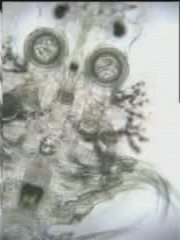A major threat in a pond or tank
Argulus, or fish lice, represent a major threat to fish health; both as a result of direct tissue damage and secondary infections. Fish lice are one of the biggest parasites (5-10 mm) and visible with the naked eye.
Argulus feed by first inserting a pre-oral sting which injects digestive enzymes into the body. They then suck out the liquidised body fluids with their proboscis-like mouth. (Take a look at the movie to see the mouth in close-up.) Feeding can take place on the skin or in the gills.
 |
A close up shot showing its eyes at the top of the picture. The two prominent circular structures near the top are the suckers used to hold onto the fish while feeding. Just below and in-between the suckers is the proboscis-like mouth that it uses for feeding |
This feeding activity causes intense irritation. Fish are damaged by the constant piercing of the skin by the stylet and there is often localised inflammation. The other danger is that opportunistic bacteria such as Aeromonas or Pseudomonas sometimes infect these damaged areas leading to skin ulcers and gill disease. It is also believed that the stylus may occasionally ‘inject’ viruses and bacteria into the fish. The various spines, suckers and hooks that lice use for attachment may also cause additional tissue damage. So all-in-all a thoroughly nasty parasite!
In addition to physical damage, affected fish are subjected to severe stress, which often leads to secondary parasite infestations such as white-spot and Costia. This type of combined attack on stressed and often weakened fish can result in high numbers of fatalities.
So quite clearly, even finding one louse warrants immediate treatment and a follow up examination to check for secondary health problems
Identification
Biologically, Argulus are crustacean parasites in the subphylum Crustacea – which means they are grouped along with shrimps, prawns and water fleas etc. Animals in this group have a rigid or semi-rigid chitin exoskeleton, which has to be moulted as they grow larger. They are in the class Branchiura, a group of crustaceans with very similar features; all branchiurians are fish parasites.
Although it is easy to spot lice when you know they are there, they are easy to miss in the rush to take skin scrapes. To the naked eye they appear as very small dark spots that are easy to overlook unless they move. They are often found in relatively sheltered areas behind the fins or around the head. They are usually easier to spot on fins rather than the body, as they tend to show up more against a plain transparent background. Lice are oval-shaped and flat and capable of moving very quickly. In an aquarium, they can sometimes be seen swimming as they move from host to host.
Fish with a heavy lice infestation will show a classic irritation response such as rubbing and flashing. At a later stage they will become lethargic. Affected fish may have focal red lesions on their body.
The life cycle of Argulus
As with most fish parasites, they have a high reproductive potential. Mating takes place on the fish, after which the female swims away and lays eggs on plants and other submerged objects. When the eggs hatch the juvenile passes through several metamorphic changes as it develops into an adult. Around 4 days after hatching, the newly-hatched juvenile actively seeks a host and continues its development on the fish. The whole cycle takes between 30 – 100 days depending on temperature. The eggs can over-winter and hatch in spring as water temperatures increase. Adults can survive without a host for several days. Any treatment plan has to take account of emerging juveniles and therefore prevailing temperatures.
Treatments
Chitin synthesis inhibitors are effective, quickly and safely against Argulus. Also known as insect gyrases, these prevent a crustacean parasite from moulting and that is fatal. Cyropro by Hikari and Microbe Lift (Click) have treatments that are effective and affordable.
On a final point. In one incident last year I examined a small aquarium that was overrun with lice. There had been no new additions of fish or plants. The only possible source was live Daphnia put in the tank from time to time!

